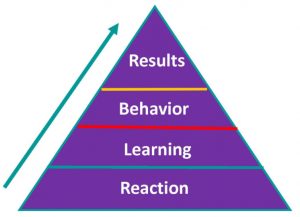Jul
28

Posted by nnlmneo on July 28th, 2016
Posted in: Blog
Are you in the first stages of planning an outreach program, but not sure how to get started? The NEO generally recommends starting your program planning by thinking about your outcomes. Outcomes are the results that you would like to see happen because of your planned activities. They are the “why we do it” of your program. However, sometimes it can be difficult to develop your outcome statements in ways that lead to measurable evaluation plans. One way to do it is to use the Kirkpatrick Model, a system that was developed 60 years ago.
Let’s start with an example. Let’s say that your needs assessment of the local vampire community found that they have a lot of health concerns: some preventative (how to avoid garlic, identifying holy water); some about the latest research (blood borne diseases, wooden stake survival); and some mental health (depression from having trouble keeping human friends). Further discussion led to finding out that while they have access to the internet from their homes, they don’t have much help with finding health information due to the fact that most of their public libraries are closed when the vampires are out and about.
So you’ve decided to do some training on both MedlinePlus and PubMed (in the evenings), and you want to come up with outcomes for your training program.
The Kirkpatrick Model breaks down training outcomes to 4 levels, each building on the previous one:

Level 1: Reaction – This level of outcome is about satisfaction. People find your training satisfying, engaging, and relevant. While satisfaction is not a very strong impact, Kirkpatrick believes it is essential to motivate people to learn.
Level 2: Learning – This outcome is that by the end of your training, people have learned something, whether knowledge, skills, attitude, or confidence.
Level 3: Behavior – This outcome is related to the degree to which people take what they learned in your training and apply it in their jobs or their lives.
Level 4: Results – This level of outcome is “the greater good” – changes in the community or organization that occur as a result of changes in individuals’ knowledge or behavior.
Back to our training example. Here are some outcome statements that are based on the Kirkpatrick Model. I am listing them here as Short-term, Intermediate and Long-term, like you might find in a Logic Model (for more on logic models, see Logic Model blog entries).
Short-term Outcomes:
Intermediate Outcomes:
Long-term Outcomes

Once you’ve stated your outcomes, you can use them in a number of ways. You can think through your training activities to ensure that they are working towards those outcomes. And you can assign indicators, target criteria, and time frames to each outcome to come up with measurable objectives for your evaluation plan.
Happy Hunting Outcomes!